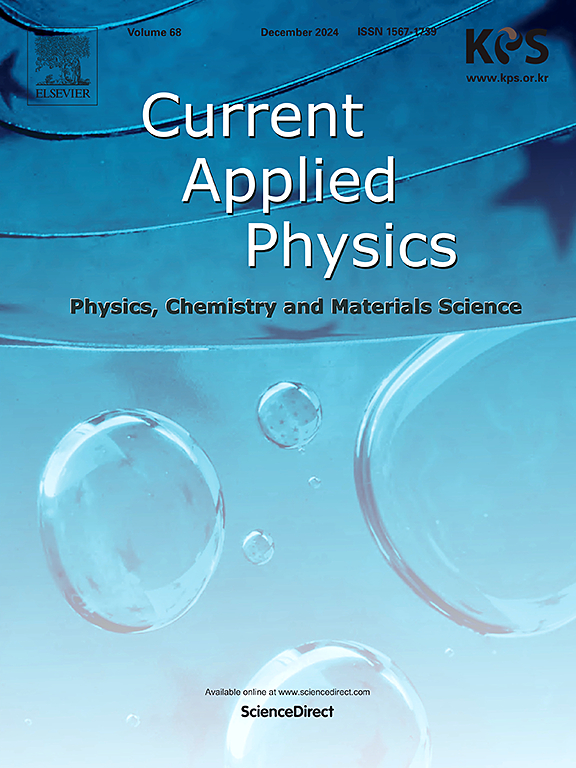防火层状碳复合材料板由使用过的棉布隔热和电磁干扰屏蔽应用
IF 3.1
4区 物理与天体物理
Q3 MATERIALS SCIENCE, MULTIDISCIPLINARY
引用次数: 0
摘要
报道了一种利用废旧棉布制备绝热碳复合板的工艺。将柔韧的棉布经蔗糖溶液浸渍后碳化,转化为刚性的碳栅格片。采用酚醛(PF)聚合物溶液浸渍碳栅格片,经固化和炭化,手工铺层制备层状碳复合板。碳复合材料板在X-Y平面上呈网格状孔隙,在横向平面上呈片状孔隙。碳复合材料板由于层状结构,在弯曲模式下表现为伪塑性破坏。通过改变PF溶液浓度从60到100 vol%,密度,抗压强度和抗折强度分别在0.45±0.0004至0.57±0.0068 g cm - 3, 0.86±0.04至2.03±0.10 MPa和2.6±0.11至4.5±0.16 MPa范围内进行调节。碳复合板具有高达470°C的抗氧化性,优异的耐火性,在0.187±0.0004至0.273±0.0014 W m−1范围内的低导热系数。K−1范围。5 mm厚度的碳复合材料板在40 ~ 67 dB范围内表现出较高的电磁干扰屏蔽效能,这是由于网格状和片状孔隙中的导电和介电损耗以及多次内部反射。本文章由计算机程序翻译,如有差异,请以英文原文为准。

Fire-resistant layered carbon composite panels from used cotton cloth for thermal insulation and EMI shielding applications
A process for preparing thermally insulating carbon composite panels (CCP) from used cotton cloth is reported. The pliable cotton cloth is transformed into rigid carbon grid sheets by carbonization after impregnation with a sucrose solution. The layered carbon composite panels are obtained by hand layup of phenol-formaldehyde (PF) polymer solution-impregnated carbon grid sheet followed by curing and carbonization. The carbon composite panels exhibit grid-like pores in the X-Y plane and lamellar-type pores in the lateral plane. Due to their layered structure, the carbon composite panels exhibit pseudo-plastic failure under flexural mode. The density, compressive strength, and flexural strength are modulated in the ranges of 0.45 ± 0.0004 to 0.57 ± 0.0068 g cm−3, 0.86 ± 0.04 to 2.03 ± 0.10 MPa, and 2.6 ± 0.11 to 4.5 ± 0.16 MPa, respectively, by varying the PF solution concentrations from 60 to 100 vol%. The carbon composite panels exhibit oxidation resistance up to 470 °C, excellent fire resistance, and low thermal conductivity in the 0.187 ± 0.0004 to 0.273 ± 0.0014 W m−1. K−1 range. The high EMI shielding effectiveness in the range of 40–67 dB exhibited by the carbon composite panels of 5 mm thickness is due to the conductive and dielectric losses and multiple internal reflections within the grid-like and lamellar-type pores.
求助全文
通过发布文献求助,成功后即可免费获取论文全文。
去求助
来源期刊

Current Applied Physics
物理-材料科学:综合
CiteScore
4.80
自引率
0.00%
发文量
213
审稿时长
33 days
期刊介绍:
Current Applied Physics (Curr. Appl. Phys.) is a monthly published international journal covering all the fields of applied science investigating the physics of the advanced materials for future applications.
Other areas covered: Experimental and theoretical aspects of advanced materials and devices dealing with synthesis or structural chemistry, physical and electronic properties, photonics, engineering applications, and uniquely pertinent measurement or analytical techniques.
Current Applied Physics, published since 2001, covers physics, chemistry and materials science, including bio-materials, with their engineering aspects. It is a truly interdisciplinary journal opening a forum for scientists of all related fields, a unique point of the journal discriminating it from other worldwide and/or Pacific Rim applied physics journals.
Regular research papers, letters and review articles with contents meeting the scope of the journal will be considered for publication after peer review.
The Journal is owned by the Korean Physical Society.
 求助内容:
求助内容: 应助结果提醒方式:
应助结果提醒方式:


